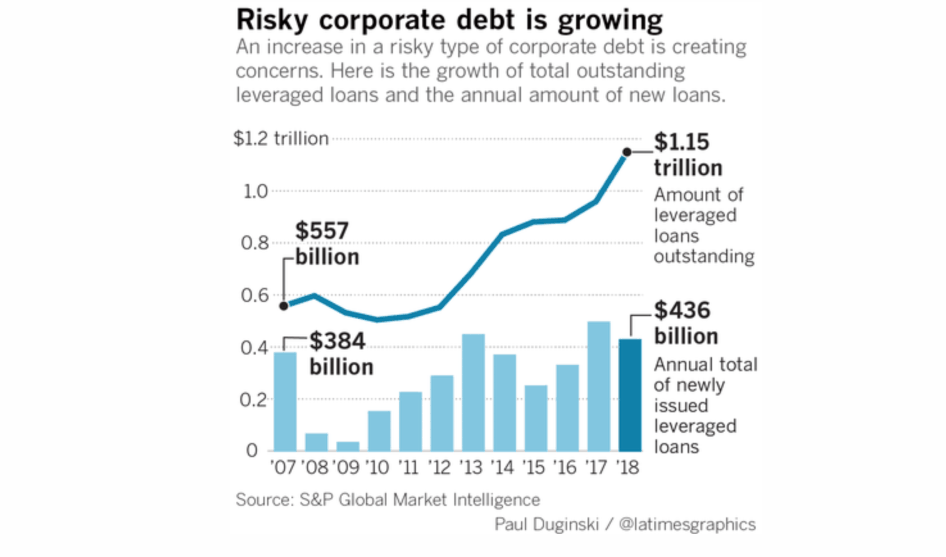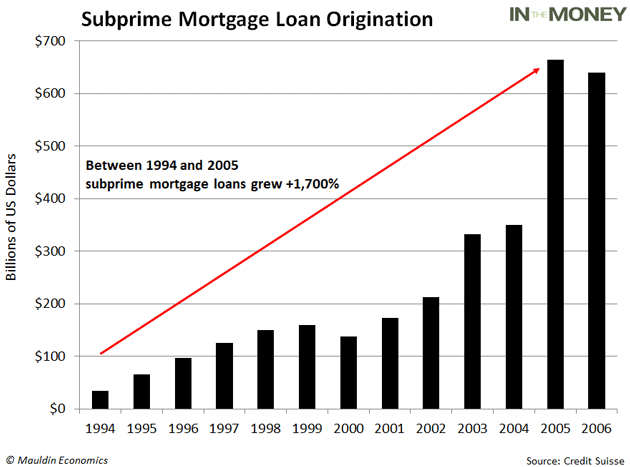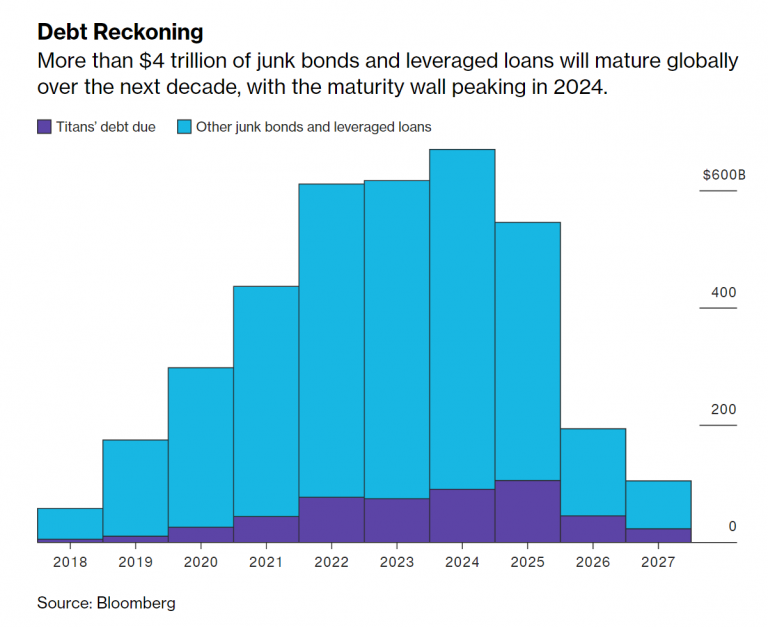What Could Go Wrong? The Fed Warns On Corporate Debt
“So, if the housing market isn’t going to affect the economy, and low interest rates are now a permanent fixture in our society, and there is NO risk in doing anything because we can financially engineer our way out it – then why are all these companies building up departments betting on what could be the biggest crash the world has ever seen?
What is more evident is what isn’t being said. Banks aren’t saying “we are gearing up just in case something bad happens.” Quite the contrary – they are gearing up for WHEN it happens.
When the turn does come, it will be unlike anything we have ever seen before. The scale of it could be considerable because of the size of some of these leveraged deals.” – Lance Roberts, June 2007
It is often said that no one saw the crash coming. Many did, but since it was “bearish” to discuss such things, the warnings were readily dismissed.
Of course, what came next was the worst financial crisis since the “Great Depression.”
But that was a decade ago, the pain is a relic of history, and the surging asset prices due to monetary policies has once again lured both Wall Street and Main Street into the warm bath of complacency.
It should not be surprising warnings are once again falling on “deaf ears.”
The latest warning came from the Federal Reserve who identified rising sales of risky corporate debt as a top vulnerability facing the U.S. financial system in their latest financial stability report. Via WSJ:
“Officials, for the second time in six months, cited potential risks tied to nonfinancial corporate borrowing, particularly leveraged loans—a $1.1 trillion market that the Fed said grew by 20% last year amid declining credit standards. They also flagged possible concerns in elevated asset prices and historically high debt owned by U.S. businesses.
Monday’s report also identified potential economic shocks that could test the stability of the U.S. financial system, including trade tensions, potential spillover effects to the U.S. from a messy exit of Britain from the European Union and slowing economic growth globally.
Specifically, the Fed warned a downturn could expose vulnerabilities in U.S. corporate debt markets, ‘including the rapid growth of less-regulated private credit and a weakening of underwriting standards for leveraged loans.’”
It has become quite commonplace to dismiss the current environment under the thesis of “this time is different.”This was also the case in 2007 where the general beliefs were exactly the same:
- Low-interest rates are expected to persist indefinitely into the future,
- A pervasive belief that Central Banks have everything under control, and;
- The economy is strong and there is “no recession” in sight.
Remember, even though no one knew it at the time, the recessions officially started just 5-months later.
The issue of “zombie corporations,” or companies that would be bankrupt already if not for ongoing low-interest rates and loose lending standards, is not a recent issue. Via Zerohedge:
“As Bloomberg reports, in a particularly striking sign, the Fed said the businesses with the biggest existing debt loads are also the ones taking on the riskiest loans. And protections that lenders include in loan documents in case borrowers default are eroding, the U.S. central bank said in its twice-a-year financial stability report. The Fed board voted unanimously to approve the document.
‘Credit standards for new leveraged loans appear to have deteriorated further over the past six months,’ the Fed said, adding that the loans to firms with especially high debt now exceed earlier peaks in 2007 and 2014.
‘The historically high level of business debt and the recent concentration of debt growth among the riskiest firms could pose a risk to those firms and, potentially, their creditors.’
Leveraged loans are routinely packaged into collateralized loan obligations, or CLOs. Investors in those securities — including insurance companies and banks — face a risk that strains in the underlying loans will deliver ‘unexpected losses,’ the Fed said Monday, adding that the secondary market isn’t very liquid, “even in normal times.”
‘It is hard to know with certainty how today’s CLO structures and investors would fare in a prolonged period of stress,’ the Fed added.”
Yes. CLO’s are back.
And it was the Central Bank’s largesse that led to the latest bubble. As noted by WSJ:
“Financial stability has remained a central focus at the Fed because of the easy-money policies employed to nurse the economy back to health in the years following the financial crisis. Critics have warned that the Fed’s large bond-buying campaigns and years of near-zero interest rates risked new bubbles.”
One of the common misconceptions in the market currently, is that the “subprime mortgage” issue was vastly larger than what we are talking about currently.
Not by a long shot.
Combined, there is about $1.15 trillion in outstanding U.S. leveraged loans — a record that is double the level five years ago — and, as noted, these loans increasingly are being made with less protection for lenders and investors.

Just to put this into some context, the amount of sub-prime mortgages peaked slightly above $600 billion or about 50% less than the current leveraged loan market.

Of course, that didn’t end so well.
Currently, the same explosion in low-quality debt is happening in another corner of the US debt market as well.

As noted by John Mauldin:
“In just the last 10 years, the triple-B bond market has exploded from $686 billion to $2.5 trillion—an all-time high.
To put that in perspective, 50% of the investment-grade bond market now sits on the lowest rung of the quality ladder.
And there’s a reason BBB-rated debt is so plentiful. Ultra-low interest rates have seduced companies to pile into the bond market and corporate debt has surged to heights not seen since the global financial crisis.”

As the Fed noted a downturn in the economy, signs of which we are already seeing, a significant correction in the stock market, or a rise in interest rates could quickly cause problems in the corporate bond market. The biggest risk currently is refinancing the debt. As Frank Holmes noted in a recent Forbes article, the outlook is rather grim.
“Through 2023, as much as $4.88 trillion of this debt is scheduled to mature. And because of higher rates, many companies are increasingly having difficulty making interest payments on their debt, which is growing faster than the U.S. economy, according to the Institute of International Finance (IIF).
“On top of that, the very fastest-growing type of debt is riskier BBB-rated bonds — just one step up from ‘junk.’ This is literally the junkiest corporate bond environment we’ve ever seen. Combine this with tighter monetary policy, and it could be a recipe for trouble in the coming months.”

Let that sink in for a minute.
Over the next 5-years, more than 50% of the debt is maturing.
As noted, a weaker economy, recession risk, falling asset prices, or rising rates could well lock many corporations out of refinancing their share of this $4.88 trillion debt. Defaults will move significantly higher, and much of this debt will be downgraded to junk.
As noted by James Grant in a recent interview:
“Many companies will get into trouble if the real interest rate on ten-year treasuries rises over 1%. These businesses are so leveraged that they can’t cover their debt payments at levels even as humble and as low as a 1% real interest rate on ten-year treasuries as it translates into corporate borrowing. Just look at the growth in the herd of listed zombies; companies whose average operating income has fallen short of covering the average interest rate expense over three consecutive years. As it turns out, the corporate living dead, as a share of the broad S&P 1500 index, are close to 14%. Former Fed-Chairman Ben Bernanke once tried to reassure everyone that the Fed could raise rates in 15 minutes if it wanted to. Well, it turns out the Fed cannot do that. So, it’s a brave new world we’re living in.”
Not Just Corporate Debt
While subprime and CDO’s blew up the markets in 2008. It isn’t just corporate debt that has ballooned to problematic levels in recent years.
There is another financial risk of epic proportions brewing currently. If you are not familiar with “shadow banking,” you should learn about it quick.
Nonbank lending, an industry that played a central role in the financial crisis, has been expanding rapidly and is still posing risks should credit conditions deteriorate.
Often called ‘shadow banking’ — a term the industry does not embrace — these institutions helped fuel the crisis by providing lending to underqualified borrowers and by financing some of the exotic investment instruments that collapsed when subprime mortgages fell apart.
This kind of lending has absolutely exploded all over the globe since the last recession, and it has now become a $52 trillion dollar bubble.
In the years since the crisis, global shadow banks have seen their assets grow to $52 trillion, a 75% jump from the level in 2010, the year after the crisis ended. The asset level is through 2017, according to bond ratings agency DBRS, citing data from the Financial Stability Board.
The real crisis comes when there is a “run on pensions.” With a large number of pensioners already eligible for their pension, and a $5 trillion dollar funding gap, the next decline in the markets will likely spur the “fear” that benefits will be lost entirely.
The combined run on the system, which is grossly underfunded, at a time when asset prices are dropping, credit is collapsing, and shadow-banking freezes, the ensuing debacle will make 2008 look like a mild recession.
It is unlikely Central Banks are prepared for, or have the monetary capacity, to substantially deal with the fallout.
As David Rosenberg noted:
“There is no way you ever emerge from eight years of free money without a debt bubble. If it’s not a LatAm cycle, then it’s energy the next, commercial real estate after that, a tech mania years after, and then the mother of all of them, housing over a decade ago. This time there is a huge bubble on corporate balance sheets and a price will be paid. It’s just a matter of when, not if.”
Never before in human history have we seen so much debt. Government debt, corporate debt, shadow-banking debt, and consumer debt are all at record levels. Not just in the U.S., but all over the world.
If you are thinking this is a “Goldilocks economy,” “there is no recession in sight,” “Central Banks have this under control,” and that “I am just being bearish,” you would be right.
But that is also what everyone thought in 2007.




The main concern should be on the banks financing zombie debt. It is widely known a lot of small oil gambles are losses and are not able to ever pay up or be profitable. Yet big banks keep financing them because this is the only way they can keep paying their debt. Everyone know the outcome of such behavior yet it is still done. As for other corporate debt that can be financed off of revenue streams, they seem ok.
We will see 2022 when the debt payments spike how corporate debt does as a whole. I don't see an eminent trigger besides a full on trade war and financial unwinding. Trump's leverage at the table for trade wars has diminished as everyone should have known as his terms drag on. A deal is better than no deal and further tariffs will endanger the economy and ruin his re-election hopes. I hope better minds prevail for the US and the global economy. As we can see tariffs have done little from stopping the trade deficit from China besides taxing the US consumer to the ground.